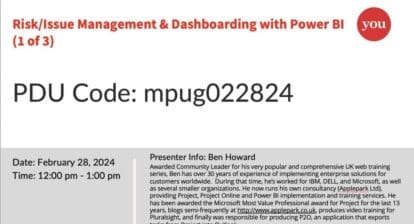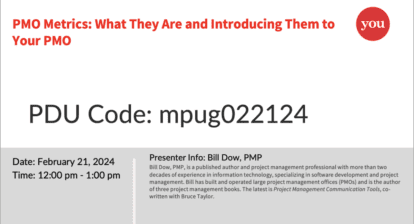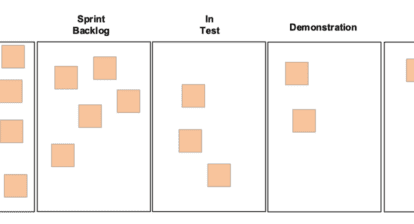 Last week, I shared the “10 Signs Your PMO is Trying to Fly ‘Alternative Facts’“. This week I provide coping mechanisms for dealing with each of those quandaries. My philosophy is simple: First, follow industry best practices to stay out of trouble. Second, use Microsoft Project Online to track your efforts and keep everybody aligned.
Last week, I shared the “10 Signs Your PMO is Trying to Fly ‘Alternative Facts’“. This week I provide coping mechanisms for dealing with each of those quandaries. My philosophy is simple: First, follow industry best practices to stay out of trouble. Second, use Microsoft Project Online to track your efforts and keep everybody aligned.
1. Senior managers are “rotated” or “reassigned” before project completion.
Often, reassignments occur because a project lacked a meticulous outline of requirements. Project Online provides seamless communication and collaboration among teams across the organization. Institutionalize the process within ALL functional and executive teams for maximum exposure. Beware of the one vote that can redirect plans in the undesired direction.
2. Project management offices are directed to and then cease weekly status metrics because they have become “distractions” to the executive staff.
Comprehension of the true “value” of basic metrics is essential. Most PMOs tend to over-design reporting, which may not be consistent project to project anyway. A standardized work breakdown structure (WBS) throughout will ensure success in reporting and generate a significant cost savings.
3. Departments institute different project management tools because they believe the “tool” is not working “correctly.”
This is a common occurrence with change in management. Project Online can communicate a consistent message across all the organizations and eliminate hundreds of two-way emails. Project status must be correct and accurate if everyone views information through a single window and not multiple channels.
4. Project failures are credited to project managers who were never assigned to the failed project.
The “blame game” can be avoided when resources are in line with strategies and the objectives of a company’s priorities. When there is no single windowpane through which to view the entire project, communication, ownership and accountability is diminished. Standardizing with real-time reporting and alignment with deliverables of project plans will directly address these issues. Effectively managing resources will save upwards of 10 percent on the company’s bottom line. Use a centralized personnel pool for resource management. This database increases the reporting accuracies. With Project Online, an organizational breakdown structure (OBS) clearly encapsulates what teams are working on and supports the ability to build contingencies by balancing portfolio priorities.
5. Project plans are abandoned, “because they take up too much time” during the weekly meetings.
Project plans may too detailed. Roll up your WBS and more project members will be able to clearly understand the project status. Compliance reporting and team lead reports must be standardized. Meticulous details should be reported in a separate meeting or rolled up under a properly executed WBS outline.
6. Senior managers report their own status or claim ownership when they edit the weekly project status rather than allow the status tool to report dynamically.
A common window or source of communication guarantees seamless communication throughout an organization. When a common, high-level WBS is built, bind it to the OBS for accountability. Managing and updating project status becomes less cumbersome. Once ownership is assigned and published, many communication issues diminish.
7. Projects expand with the addition of “unplanned phases” that were never part of their planning or requirements while resources report and document work time to “non-project” activities.
Unplanned phases surface in projects due to incomplete, changing requirements or cultural blocks to implementation. Some projects may spend more time during the “implementation phase” than the entire rest of the project. This resistance is often initiated by staff who don’t value a centralized enterprise project management (EPM) system or simply don’t want to change how they do their work. If the IT department is at an offsite location, project approval will take extra precious time, depending on the size of the organization. Project Online simplifies this major roadblock by integrating the administration within the tool. The benefit of no extra servers, continuous data backups and redundant data centers will be saving time in the project implementation.
8. Senior management or immediate subordinates refuse to use standard scheduling metrics on projects because they believe it has “no purpose” and question the “accuracy” of the weekly status due to a “language” issue.
Optimizing planning will improve quality, accuracy and cost of project initiatives with each team’s status. It enables the project team to move beyond the day-to-day tactical zone and towards the strategic level. Consistency and conformity in project plans for stakeholders are priorities using a common WBS and assigned ownership.
9. Project teams no longer use Project Management Professionals or Microsoft Certified Technology Specialists since senior executives have decided to rely on nepotism over qualifications.
Training is critical to any successful project management team. Building plans is more complex. Project Online will allow for the use of common templates or your company’s standardized tasks for repeating activities in all plans. Institutionalize this process among your teams. Qualified project managers are known to optimize planning and improve quality and costs of the project initiatives.
10. Companies invest substantial amounts reinventing the project management methodology and then rename it rather than use the proven industry-standard Project Management Book of Knowledge.
Reinventing best practices is a budget- and time-buster. Sharing best practices through two-way communication channels — whether online, with Slack, Teams, face-to-face or some other mechanism — will bring those best practices to the forefront and augment them with continuous enhancements. By emphasizing effective governance and tested PM methodologies, you ensure that your toolset will execute on the minor project tasks while you take care of the company business.
Share your own strategies for PM success in the face of alternative facts in the comments below.
Related Content
Webinars (watch for free now!):
Leveraging Project, Project Server and Project Online for Better Communications
The Basics of Schedule Planning – It’s ALL about Communication
Articles:
Communication: 5 Ways to Improve Your Project’s Lessons Learned
Size Matters (in Plan Communications)




